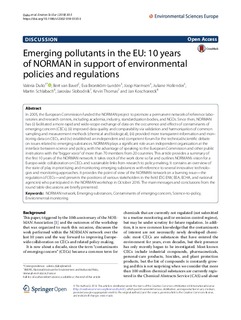| dc.contributor.author | Dulio, Valeria | |
| dc.contributor.author | van Bavel, Bert | |
| dc.contributor.author | Broström-Lundén, Eva | |
| dc.contributor.author | Harmsen, Joop | |
| dc.contributor.author | Hollender, Juliane | |
| dc.contributor.author | Schalbach, Martin | |
| dc.contributor.author | Slobodnik, Jaroslav | |
| dc.contributor.author | Thomas, Kevin V | |
| dc.contributor.author | Koschorreck, Jan | |
| dc.date.accessioned | 2018-06-15T09:06:57Z | |
| dc.date.available | 2018-06-15T09:06:57Z | |
| dc.date.created | 2018-03-14T11:14:12Z | |
| dc.date.issued | 2018 | |
| dc.identifier.citation | Environmental Sciences Europe. 2018, 30, 5. | nb_NO |
| dc.identifier.issn | 2190-4715 | |
| dc.identifier.uri | http://hdl.handle.net/11250/2501741 | |
| dc.description.abstract | In 2005, the European Commission funded the NORMAN project to promote a permanent network of reference laboratories and research centers, including academia, industry, standardization bodies, and NGOs. Since then, NORMAN has (i) facilitated a more rapid and wide-scope exchange of data on the occurrence and effects of contaminants of emerging concern (CECs), (ii) improved data quality and comparability via validation and harmonization of common sampling and measurement methods (chemical and biological), (iii) provided more transparent information and monitoring data on CECs, and (iv) established an independent and competent forum for the technical/scientific debate on issues related to emerging substances. NORMAN plays a significant role as an independent organization at the interface between science and policy, with the advantage of speaking to the European Commission and other public institutions with the “bigger voice” of more than 70 members from 20 countries. This article provides a summary of the first 10 years of the NORMAN network. It takes stock of the work done so far and outlines NORMAN’s vision for a Europe-wide collaboration on CECs and sustainable links from research to policy-making. It contains an overview of the state of play in prioritizing and monitoring emerging substances with reference to several innovative technologies and monitoring approaches. It provides the point of view of the NORMAN network on a burning issue—the regulation of CECs—and presents the positions of various stakeholders in the field (DG ENV, EEA, ECHA, and national agencies) who participated in the NORMAN workshop in October 2016. The main messages and conclusions from the round table discussions are briefly presented. | nb_NO |
| dc.language.iso | eng | nb_NO |
| dc.publisher | SpringerOpen | nb_NO |
| dc.rights | Navngivelse 4.0 Internasjonal | * |
| dc.rights.uri | http://creativecommons.org/licenses/by/4.0/deed.no | * |
| dc.title | Emerging pollutants in the EU: 10 years of NORMAN in support of environmental policies and regulations | nb_NO |
| dc.type | Others | nb_NO |
| dc.description.version | publishedVersion | nb_NO |
| dc.rights.holder | © The Author(s) 2018 | nb_NO |
| dc.source.volume | 30 | nb_NO |
| dc.source.journal | Environmental Sciences Europe | nb_NO |
| dc.identifier.doi | 10.1186/s12302-018-0135-3 | |
| dc.identifier.cristin | 1572743 | |
| cristin.unitcode | 7464,0,0,0 | |
| cristin.unitcode | 7464,20,13,0 | |
| cristin.unitname | Norsk institutt for vannforskning | |
| cristin.unitname | Økotoksikologi | |
| cristin.ispublished | true | |
| cristin.fulltext | original | |
| cristin.qualitycode | 1 | |

